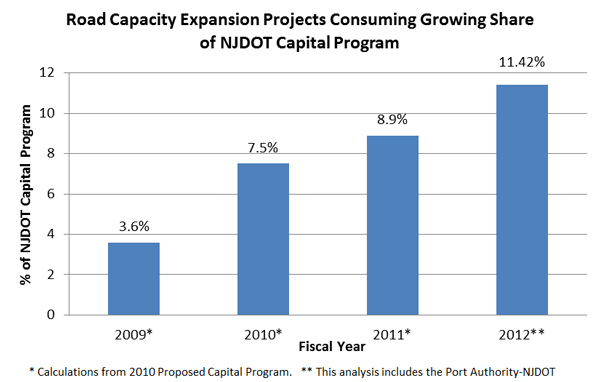
[This post was modified on September 19, 2012]
What’s the difference between NJDOT’s Final Transportation Capital Program for Fiscal Year 2012, made publicly available this month, and the agency’s draft program released in March 2011? A lot. And although the agency’s yearly capital programs are commonly considered “fluid documents,” the fluidity between this year’s draft and the Final Capital Program is a cause for a concern.
While overall funding is still largely the same between the two documents – both documents outline a $3.5 billion spending plan, with NJDOT receiving $2.3 billion (in the draft plan) and $2.37 billion (in the final plan) and NJ Transit receiving $1.164 billion in the draft and final plan – there are significant differences between the two documents, most alarmingly in spending on road new capacity projects. The Final Capital Program includes an additional road new capacity project, and two road new capacity projects funded in the draft program received considerably more money in the final program.
According to TSTC’s analysis, the Final Capital Program spends an additional $18.69 million on projects that increase road capacity. This growth in spending is not insignificant – with the increased spending on these projects, spending on road new capacity projects grew to over 11% of the final program, up from 10.95% in the draft program. That draft program would have committed the department to spending the highest percentage of funds on new road capacity in nearly a decade. This further increase from the draft program is extremely troubling.
The final program also decreases funding for bicycle and pedestrian projects by $2 million. This means that total bike/ped funding in the final program is 2.58% of total NJDOT funding, down from 2.74% in the draft program, although new projects have been added. New to the list are: Essex County’s Rahway River Corridor Greenway Bicycle and Pedestrian Path ($400,000), Hudson County’s 6th Street Viaduct Pedestrian and Bicycle Pathway ($1.4 million) and a bike and pedestrian path along the Delaware River between Stacy Park and Assunpink Creek (Mercer County, $944,190). But it does not fund the New Brunswick bikeway (Middlesex County, $7.1 million) or a project to make pedestrian improvements at Route 322 and Woodland Drive in Atlantic County ($600,000).
One new road capacity project in the 2012 Final Capital Program that is not in the Draft Program widens Gloucester County’s Egg Harbor Road. The two other capacity-adding projects that receive more money in the Final Capital Program than they did in the draft program address parts of Route 17 in Bergen County, funded at $14.7 million, up from $2 million; and Route 295/42/I-76 in Camden County, funded at $101.7 million, an increase from $96.7 million.
While there was opportunity for public comment on the draft program, no such opportunity exists for the final document. But the changes between the Draft and Final Capital Programs are notable and not immaterial, exacerbating the existing trend towards new road expansions. Even as the amount New Jersey spends on roadway expansion is growing to levels not seen in years, spending on transit is shrinking.
Image: TSTC.

[…] […]
[…] was on the cutting edge of progressive transportation planning. Unfortunately, today Network blog Mobilizing the Region offers more evidence that that promising moment has passed under Governor Chris Christie. Christie […]
Hey New Jersey, elections have consequences!
Route 206 definitely is in need of widening. This road has been congested for years now.
Somerset NJ Real Estate